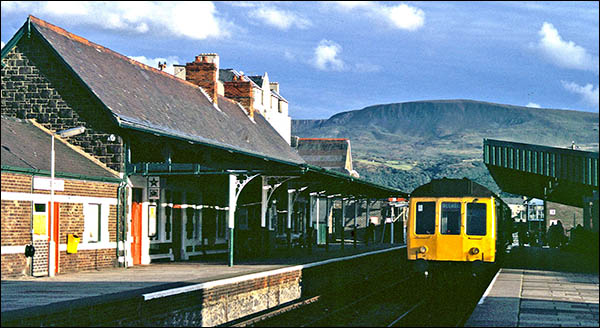Barmouth railway station
This station’s opening in 1867 triggered Barmouth’s development as a seaside resort. The photos, courtesy of John Davies, show the station in 1962 with freight and passenger trains, and in 1984 with a northbound diesel train.
The coastal railway from Pwllheli to Machynlleth was opened in stages, with many setbacks. Completion of the long bridge over the Mawddach estuary at Barmouth opened the full length of the route to trains. On the opening day, railway officials proudly arrived at Barmouth on the 7am passenger train from Porthmadog, only to be served with Chancery injunctions. Three landowners claimed they were owed money, so the line north of Barmouth was temporarily closed!
 South of the estuary, Barmouth Junction station (later renamed Morfa Mawddach) had opened in 1865. A route diverged eastwards to Penmaenpool, later continuing to Bala, Llangollen and Ruabon.
South of the estuary, Barmouth Junction station (later renamed Morfa Mawddach) had opened in 1865. A route diverged eastwards to Penmaenpool, later continuing to Bala, Llangollen and Ruabon.
In December 1909 a crowd at Barmouth station gathered around the railway carriage in which David Lloyd George, Chancellor of the Exchequer and future Prime Minister, was travelling home to Pwllheli. Urged by the crowd, he gave an impromptu speech while the train paused at the station.
 Barmouth beach came right up to the railway south of the station until well into the 20th century. The railway had to be cleared of sand during or after westerly gales. In stormy weather on New Year’s Day 1916, eight men in three groups were clearing sand south of the station when one of them was struck and killed by the 7.58pm from Barmouth Junction. Platelayer Edward Jones, 44, left a widow and three children in Arthog.
Barmouth beach came right up to the railway south of the station until well into the 20th century. The railway had to be cleared of sand during or after westerly gales. In stormy weather on New Year’s Day 1916, eight men in three groups were clearing sand south of the station when one of them was struck and killed by the 7.58pm from Barmouth Junction. Platelayer Edward Jones, 44, left a widow and three children in Arthog.
The route was owned by the Oswestry-based Cambrian Railways until the company merged with the Great Western Railway in 1923. It was known as the “Cambrian Coast” line, distinguishing it from the other CR lines. The scenic railway along the coast is still known as the Cambrian Coast line. Its many stations provide easy access to the Wales Coast Path.
With thanks to John Davies
Postcode: LL42 1LS View Location Map



